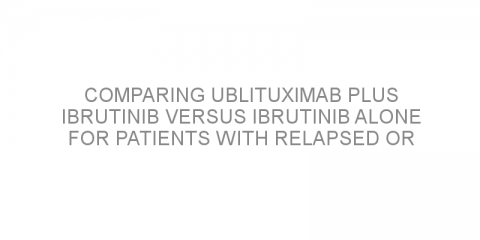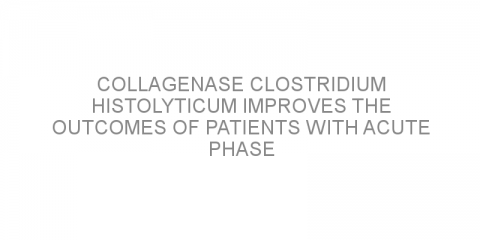In a nutshell This study evaluated the benefit of adding hyperthermic intraperitoneal chemotherapy (HIPEC) to cytoreductive surgery (CS) for the treatment of colorectal cancer (CRC) that has spread to the peritoneum (the lining of the abdomen that covers all abdominal organs). The study found that HIPEC added to CS did not improve the outcomes of...
Read MoreComparing ublituximab plus ibrutinib versus ibrutinib alone for patients with relapsed or refractory high-risk chronic lymphocytic leukemia
In a nutshell This study investigated the safety and effectiveness of adding ublituximab (TG-1101) to ibrutinib (Imbruvica) treatment for patients with relapsed or refractory (r/r) chronic lymphocytic leukemia (CLL). The data showed that adding ublituximab to ibrutinib significantly improved the overall response rate compared to ibrutinib alone...
Read MoreComparing the activity and safety of [177Lu]Lu-PSMA-617 versus cabazitaxel in patients with metastatic castration-resistant prostate cancer
In a nutshell This study compared the effectiveness and safety of lutetium-177 [177Lu]-PSMA-617 (177LuPSMA) versus cabazitaxel (Jevtana) for the treatment of patients with metastatic castration-resistant prostate cancer (mCRPC). The data showed that 177LuPSMA treatment showed a higher response with fewer side effects in these patients. Some...
Read MoreReal-world outcomes of fulvestrant as first-line treatment of postmenopausal women with advanced breast cancer.
In a nutshell This study investigated the effectiveness of fulvestrant (Faslodex) as a first-line treatment for postmenopausal women with estrogen receptor-positive (ER+) metastatic breast cancer (BC) in a real-world setting. The data showed that the outcomes of these patients in the real-world setting were similar to clinical trials...
Read MoreCan stereotactic body radiotherapy can be used as an alternative to minimal invasive surgery for early-stage non-small cell lung cancer?
In a nutshell This article compared the use of video-assisted thoracoscopic lobectomy (VATL) versus stereotactic body radiotherapy (SBRT) for the treatment of early-stage non-small cell lung cancer (NSCLC). The authors found that SBRT could provide an alternative treatment option for these patients. Some background Early-stage NSCLC is...
Read MoreDo single or combined immune checkpoint inhibitors improve outcomes in patients with advanced non-small cell lung cancer?
In a nutshell This article looked at the effectiveness and safety of first-line immune checkpoint inhibitors (ICIs) alone or as a combination compared to platinum-based chemotherapy (PBC) for advanced non-small cell lung cancer (NSCLC). The authors found that ICI therapy may improve the survival of these patients while having reduced side...
Read MoreEuropean medicines agency review of acalabrutinib as treatment for chronic lymphocytic leukemia
In a nutshell This review aims to analyze the trials that led to acalabrutinib (Calquence) gaining regulatory approval in the European Union for the treatment of chronic lymphocytic leukemia (CLL). Some background Acalabrutrinib is a targeted therapy mainly used for the treatment of non-Hodgkin lymphoma. It...
Read MoreComparing prostatic artery embolization to transurethral resection of the prostate in patients with benign prostatic hyperplasia.
In a nutshell This study compared the effectiveness and safety of prostatic artery embolization (PAE) and transurethral resection of the prostate (TURP) for patients with lower urinary tract symptoms (LUTS) from benign prostatic obstruction (BPO). The data showed fewer complications but lower effectiveness in improving LUTS with PAE compared to...
Read MoreHow effective is idarubicin-substituted BEAC (IEAC) as a conditioning regimen for patients with B-cell non-Hodgkin’s lymphoma undergoing ASCT?
In a nutshell This study compared the BEAC (BCNU, etoposide, cytarabine, and cyclophosphamide) and IEAC (idarubicin, etoposide, cytarabine, and cyclophosphamide) regimens before autologous stem cell transplantation (ASCT) in patients with relapsed/refractory (r/r) and aggressive B-cell non-Hodgkin lymphoma (NHL). The study found that IEAC regimen...
Read MoreCollagenase Clostridium histolyticum improves the outcomes of patients with acute phase Peyronie’s disease
In a nutshell This study investigated the effectiveness and safety of Collagenase Clostridium histolyticum (CCH) in the treatment of acute phase Peyronie’s disease (PD). Researchers suggested that CCH therapy improves the outcomes of these patients. Some background PD consists of the formation of scar tissue inside the penis. It affects...
Read MoreAxonics sacral neuromodulation system improves the treatment outcomes of patients with urinary urgency incontinence.
In a nutshell This study investigated the effectiveness and safety of the Axonics System® for treating urinary urgency incontinence (UUI). Researchers suggested that this treatment was associated with improved effectiveness and safety in patients with UUI. Some background UUI occurs when there is a sudden urge to urinate. This is caused by the...
Read MoreHigh-dose rate intraoperative brachytherapy is associated with improved outcomes in patients with high-risk rectal cancer
In a nutshell This study compared the effectiveness of electron beam radiotherapy (EBR) and high-dose brachytherapy (HDB) during surgery in patients with rectal cancer who underwent an incomplete removal of the cancer. Researchers suggested that HDB was associated with a lower risk of recurrence in these patients. Some background Colorectal...
Read More


![Comparing the activity and safety of [177Lu]Lu-PSMA-617 versus cabazitaxel in patients with metastatic castration-resistant prostate cancer](https://medivizor.com/blog/wp-content/uploads/et_temp/wapt_image_36241-19376_480x240.png)











